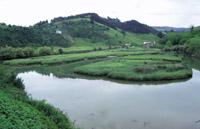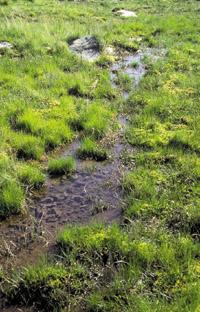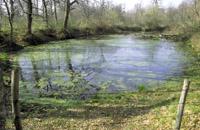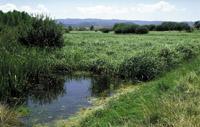Wetlands of the Basque Country (I)

However, until recently, the knowledge and fame of wetlands has been almost exclusively associated with aquatic birds, which are the most striking component of these natural systems. On many occasions these have been the only element used for public dissemination and the main objective of systematic scientific research carried out in wetlands. Fortunately, a few years ago scientific studies on wetlands have multiplied and diversified, helping to better understand the functioning of wetlands and their biological wealth, and serving to demonstrate the importance of landscape units for the development of various hydrological, geochemical, sedimentary and ecological processes. Thanks to this, wetlands abandoned until then for not hosting communities of aquatic birds have begun to be valued and integrated into protection programmes.
For this reason, despite the fact that there are still many studies to be carried out around wetlands, the most important tasks are now the dissemination and dissemination of all these knowledge and the design of effective policies for the protection and management of wetlands, since the mentality that perceives wetlands as an unhealthy and barbose medium is still very widespread today, which makes many wetlands continue to serious degradation processes.
Despite the fact that in the Basque Country there are no wetlands as wide as Doñana or the Wadden Sea, the diversity of small and medium-sized wetlands and, in general, the unknown. Therefore, throughout all these articles we will help you to better understand this important part of our natural heritage. We hope you like it.
What are wetlands?
The definition of wetlands is not an easy task. Diffuse morphological characteristics (indefinite limits and little depth) and their variable character (depending on the time the shape of wetlands can be very different) that wetlands usually present make it difficult to find an adequate definition. This difficulty has allowed numerous definitions for wetlands to appear. Below are some of the definitions used for the definition of wetlands, in the confidence that we all understand better what wetlands are.

Some scientists have proposed to define wetlands as areas that serve to archer feet but do not serve to swim. This definition, even if it seems joke, is nothing wrong, since it refers to the most important characteristics of wetlands: the presence of water and its scarce depth. This definition shows that deep lagoons and this type of aquatic systems are not wetlands, although in them the aquatic environment predominates, but governs the interaction between water and land in wetlands. However, it does not serve to define all wetlands. Although in some wetlands there is no surface water to wet the feet, in others there is sufficient depth to swim, there is no doubt that they are wetlands.
Another definition points to wetlands as transition areas between terrestrial and aquatic zones, both continental (rivers and lakes) and marine. This definition is adequate for wetlands that develop on the coast and on the shores of lakes and rivers, but does not include wetlands that appear inside outside the water/land limit. However, in this definition, an important and novel element appears: that wetlands are border ecosystems between different zones.
From the ecological point of view, an interesting definition is that which points to wetlands as aspects that present a positive water irregularity towards a drier environment. This definition, in addition to serving the humid zones exposed to water, includes the so-called cryptowetlands, which allow the development of various soils and plants and which are characterized by greater soil humidity. However, the concept of positive irregularity is not suitable for well-differentiated wetlands in the previous definition, located between the terrestrial and aquatic environment.
The definition of all the above features could be as follows: wetlands are natural systems conditioned by interaction between the aquatic and terrestrial environment. In them the exact harmonization of the climatic factors, the relief, the soil and the water regime causes an important increase of the humidity that directly affects the physicochemical and biological processes in these aspects.
Taking into account what has been said so far, it can be affirmed that the delimitation and separation of wetlands can be carried out through three basic elements: the first would be the appearance of a surface of shallow water or a water table (groundwater near or at the level of the terrestrial surface). The second would be the appearance of hydromorphic soils with permanent or occasional water saturation. The last would be the development of hydrophyte vegetation (plants that develop in water or in submerged areas) or hygrophites (plants that develop in areas with permanent or sporadic aquatic saturation). In these three components, the most important is water, since although there can be wetlands without vegetation (hypersaline lakes) or humid zones without vegetation or hydrochromatic soils (rocky cavities), there is no wetland that does not present water permanently or sporadically.
In addition, it should be taken into account that another important element of these wetland understanding systems is variability. The variability of wetlands is not only due to the diversity of wetland types, but also to their spatial and temporal variability. Depending on climatic changes, the same wetland can present deep-sea wetland characteristics, lagoons or cryptowetlands, and the same can occur throughout the area of each wetland, since in the same wetland, different types of wetlands can appear, forming a mosaic of wetlands.
Ecology of wetlands

In general, it can be affirmed that all wetlands are areas of great ecological importance, since in addition to being shelters of fauna and flora with special adaptations to live in these ecosystems, they affect processes and factors external to the limits of wetlands, such as the regulation of water cycles and floods, the recovery of limiting foods, the creation of different microclimates, the diversification of the landscape, etc.
Among the factors that condition the characteristics of wetlands are the following: on the one hand, the origin of the water generated by the wetland is of vital importance, since it conditions the nature of the wetland water. Also important is the size of the wetland and the aspect of the basin, since they totally condition the composition and development of the communities of living beings that develop in it. On the other hand, the relationship between the surface and depth of the wetland that conditions the level of production of the water mass should also be taken into account, since this indicates the importance of the phosphate layer (layers in which photosynthesizing living beings can direct photosynthesis) over the total volume of water. Finally, the physicochemical characteristics of water, that is, the concentrations of temperature, oxygen and carbon dioxide, turbidity of water, quantity of mineral foods, etc.
According to the above, it is evident that wetlands can be very different. However, with great simplification and taking into account only the quantity of food and the degree of production, wetlands can be divided into two major types: oligotrophic and eutrophic.
Oligotrophic wetlands
Wetlands with little food in water are oligotrophic. Although there is a great diversity within them, most are wetlands that develop in mountain areas (rivers, mountain lakes, peatlands) and are usually small or medium-sized wetlands.

The causes of the low production of organic matter due to the shortage of indicated foods and their low production should be sought in different factors. The influence of all these factors is not the same in all oligotrophic wetlands, so food shortages are more pronounced in some cases than in others. Among these factors, it should be noted, on the one hand, that the water that supplies these wetlands, in addition to coming directly from the rain or snow, has a short route before reaching the area and, therefore, carries few mineral foods. On the other hand, the mountain climate makes the water temperature relatively low, which slows down all biological processes. Finally, it must be taken into account that these wetlands predominate the steep banks that prevent the development of aquatic and swampy vegetation. Therefore, oligotrophic wetlands are low-yielding ecosystems that are not able to maintain many living things, so species diversity and density are also relatively low.
Eutrophic wetlands
Wetlands with the highest concentration of nutrients in water are eutrophic. Eutrophic wetlands have a great diversity, from estuaries and marshes to ponds in arid areas, with countless eutrophic wetlands.
The richness of food makes eutrophic wetlands ecosystems with high levels of production. The richness of food is a consequence of several factors that converge in these wetlands. On the one hand, for its long journey before reaching the wetland or for the abundance of flows it receives from its shores, water has high concentrations of nutrients (minerals and organic). On the other hand, the small depth of water makes the phosphate layer occupy an important part of the volume of water, which allows (along with the availability of mineral foods) a great development of phytoplankton. The fertility of phytoplankton causes the development of a rich zooplankton, so the amount of organic matter that is kept in suspension is very high. Finally, since the margins of these wetlands are usually quite flat, the vegetation that develops on the banks and in the waters is abundant.
Buletina
Bidali zure helbide elektronikoa eta jaso asteroko buletina zure sarrera-ontzian











